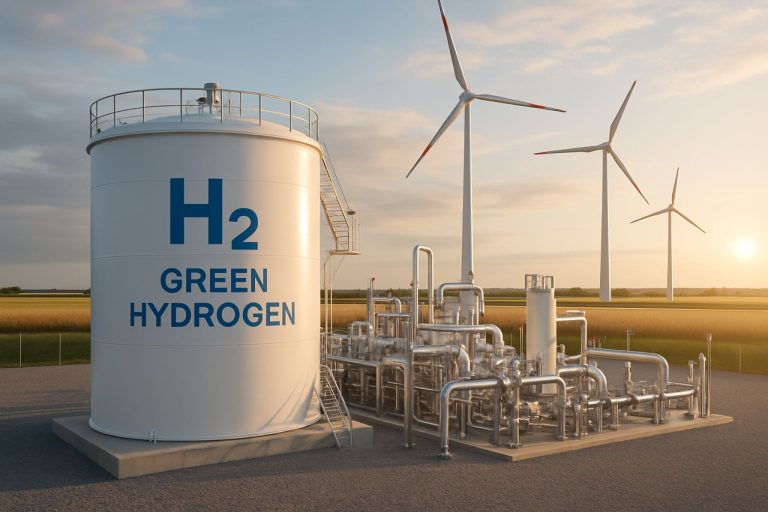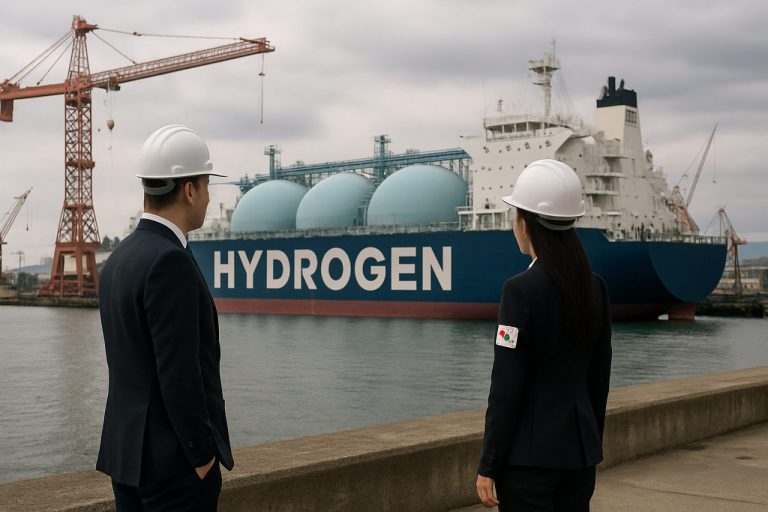
- A landmark partnership between ABS and the Hydrogen Ship Technology Center is advancing hydrogen ship technology for clean maritime transport.
- Engineering breakthroughs are needed to safely store and transport super-cooled liquid hydrogen at sea, driving innovation in ship design and propulsion.
- Hydrogen is positioned as a key solution for a carbon-neutral maritime supply chain, with South Korea aiming to build the world’s largest liquid hydrogen carrier.
- Progress in hydrogen propulsion could accelerate energy conversion and storage advancements across industries.
- This collaboration signals a new era in clean energy shipping, highlighting the importance of international partnerships in tackling climate change.
A new alliance is taking shape on the waterfronts of innovation, where the salty air is charged with urgency and promise. The American Bureau of Shipping (ABS), a titan in maritime safety and classification, has joined forces with the Hydrogen Ship Technology Center at Pusan National University—a powerhouse of South Korean research. The shared mission: to chart the future of the sea, fueled not by oil or gas, but by the clean, elusive atom at hydrogen’s core.
Engineering the Impossible
Transporting hydrogen is no small feat. In its liquid state, hydrogen is as cold as Saturn’s night—nearly minus 253 degrees Celsius. Keeping it stable at these cryogenic extremes aboard a ship that careers through storm and salt spray demands not just careful insulation, but revolutionary engineering in every rivet and seam. Both partners bring uncommon strengths to the table: ABS, with its legacy of safeguarding complex ship designs, and the Hydrogen Ship Technology Center, which has become a lodestar for research in advanced propulsion and storage systems.
Forging the Hydrogen Supply Chain
Hydrogen is widely hailed as the fuel that could power a carbon-neutral world. Yet moving it from factory to continent remains the critical—and unsolved—link in the green energy chain. If this collaboration delivers as planned, the fruit will be fleets of gigantic hydrogen carriers plying oceans and stitching together a planetary network of clean energy. South Korea’s government has put its weight behind this vision, with the Hydrogen Ship Technology Center designated as the vanguard of its effort to build the world’s largest liquid hydrogen transport vessel.
Pioneering Propulsion for a New Era
This partnership moves beyond blueprints, reaching into uncharted technical waters. Cracking the code of hydrogen propulsion at sea could ripple far beyond shipping, accelerating breakthroughs in storage and energy conversion on land as well. If successful, these innovations may not just ferry fuel—they could reshape shipbuilding itself.
The Takeaway
We stand at the cusp of a maritime revolution. With global giants now working hand-in-glove, the prospect of hydrogen-fueled supertankers advances from feverish dream to approaching reality. Their progress is about more than ships: it’s a statement that true climate action is forged at the intersection of scientific rigor, national ambition, and bold international collaboration.
To explore the science powering this clean energy revolution or learn how maritime classification shapes safer seas, visit the official sites of ABS and Pusan National University.
This Hydrogen-Powered Shipping Breakthrough Could Change Global Trade Forever—Here’s How
Spotlight: The Pioneering Partnership Between ABS & Pusan National University
The alliance between the American Bureau of Shipping (ABS) and the Hydrogen Ship Technology Center at Pusan National University marks a pivotal moment in maritime innovation. While the original article outlined their mutual goal of developing hydrogen-fueled shipping, there’s much more to this story. Here, we deep-dive into the facts, forecasts, engineering hurdles, and real-world impacts of this project—along with pressing questions and actionable tips for those poised to ride the hydrogen wave.
—
1. Why Hydrogen Shipping Matters—Market Forecasts & Industry Trends
Explosive Growth Predicted:
According to DNV’s “Maritime Forecast to 2050” and the Hydrogen Council, hydrogen and its derivatives (like ammonia) could make up 20–50% of marine fuels by 2050. Global hydrogen demand is projected to increase sixfold by mid-century as shipping, heavy industry, and power generation sectors decarbonize.
Current Investments:
Japan, South Korea, and the EU are already investing billions in hydrogen infrastructure, including ports and bunkering facilities. According to the International Energy Agency (IEA), over 200 new hydrogen projects have launched since 2022.
—
2. What Makes Maritime Hydrogen Transport So Difficult?—Engineering & Security
Extreme Cryogenic Storage:
Liquid hydrogen must be kept at –253°C, nearly absolute zero. This requires vacuum-insulated tanks, advanced cryocoolers, and robust containment systems to prevent boiling off during transit—a challenge magnified at sea.
Materials Science Risks:
Hydrogen embrittles metals, especially at cold temperatures, leading to unique fatigue and safety challenges for ship hulls and pipes—a focus of ABS expertise.
Security Protocols:
Hydrogen is flammable with a wide explosive range in air. Safety regulations and real-time monitoring must be equivalent or superior to those used for LNG carriers. ABS is drafting specialized guidelines for hydrogen shipping (see updates from ABS).
—
3. How Will These Vessels Be Built and Operated?—Features, Specs & Pricing
Key Features:
– Insulated Storage Tanks: Larger and more complex than LNG tanks.
– Hydrogen-Ready Engines: Use either pure hydrogen or blend it with marine diesel/ammonia.
– Fuel Cells Onboard: Solid oxide or proton-exchange membrane (PEM) fuel cells offer nearly zero-emission power.
– Digital Twin & AI Monitoring: Predictive maintenance and real-time leak detection are essential due to hydrogen’s properties.
Specs & Pricing:
While no commercial hydrogen carrier is operational yet, initial prototypes are expected to cost 50–100% more than equivalent LNG newbuilds due to tank and engine complexities (estimated $120–180 million per vessel; Lloyd’s Register, 2023).
—
4. Industry Use Cases & Real-World Applications
Who Stands to Benefit?
– Green Hydrogen Exporters: Australia, Middle East, North Africa, Chile, and Norway are eyeing global markets.
– Heavy Industry & Energy Hubs: Major ports (e.g., Rotterdam, Busan, Singapore) plan to become “hydrogen bunkering” nodes.
– Power Grids & Chemical Plants: Liquid hydrogen shipped to Japan, Germany, and South Korea will be converted into power or ammonia fertilizers.
Life Hack:
If you’re an investor or maritime professional, start tracking port development grants, local regulations, and emerging hydrogen hubs—early movers will have a market edge.
—
5. Controversies, Limitations & Environmental Impact
Pros:
– Potential for true zero-carbon shipping
– Synergy with green hydrogen from renewables (wind, solar, hydro)
Cons & Limitations:
– Energy-intensive production: Most hydrogen is still made from natural gas (“grey hydrogen”)
– Technology readiness: First commercial ships unlikely before 2028–2030
– Infrastructure gap: Ports worldwide need expensive retrofitting
Controversy:
“Hydrogen hype” vs. reality—critics warn against overpromising and underdelivering on near-term emissions reductions. (World Economic Forum, 2023)
Sustainability Insight:
Hydrogen can be truly green only if made using renewable-powered electrolysis, not fossil fuels. ABS and Pusan’s initiative will indirectly pressure producers to clean up hydrogen sourcing.
—
6. Reviews, Expert Opinions & Comparisons
Reviews & Comparisons:
– Hydrogen vs. LNG Ships: Hydrogen emits only water vapor when combusted or used in fuel cells, versus carbon emissions from LNG.
– Expert Take: Dr. Patrick Molloy (Rocky Mountain Institute): “Hydrogen will be critical for deep-sea decarbonization—but only if we solve cost, safety and global supply chain issues.”
—
7. Most Pressing Questions—Answered
– Is liquid hydrogen shipping safe?
With rigorous engineering and digital monitoring, risks can be managed, though the challenge is higher than with LNG.
– When will the first hydrogen supertanker sail?
Pilot projects are expected by 2028–2030, with full commercialization possibly after 2035.
– Will it be affordable?
Initial costs will be high, but economies of scale and innovation are expected to lower costs by mid-century. Subsidies and carbon taxes could accelerate adoption.
—
8. Actionable Recommendations & Quick Tips
For Professionals:
– Upskill in cryogenics, fuel cell maintenance, and hydrogen safety protocols.
– Network with industry bodies (e.g., ABS, International Maritime Organization).
– Monitor subsidies and technology trials in Korea, Japan, and the EU.
For Policymakers:
– Prioritize port retrofits for hydrogen docking and refueling.
– Invest in green hydrogen production at home and secure trade agreements.
For Investors & Tech Innovators:
– Track companies involved in hydrogen tank, fuel cell, and digital ship monitoring innovation.
– Early investments in port infrastructure or supply chain tech can offer long-term rewards.
E-E-A-T Best Practice:
Always review safety guidelines and technical standards from reputable organizations (ABS, IEA, IMO) before entering this sector.
—
Conclusion
Hydrogen shipping is poised to redefine global trade and maritime decarbonization. The ABS–Pusan National University partnership signals a bold leap—but realizing this promise demands robust engineering, clear-eyed investment, and green energy sourcing. Track this transformation closely: the clean energy revolution at sea is just beginning.
Explore further at ABS and Pusan National University.



